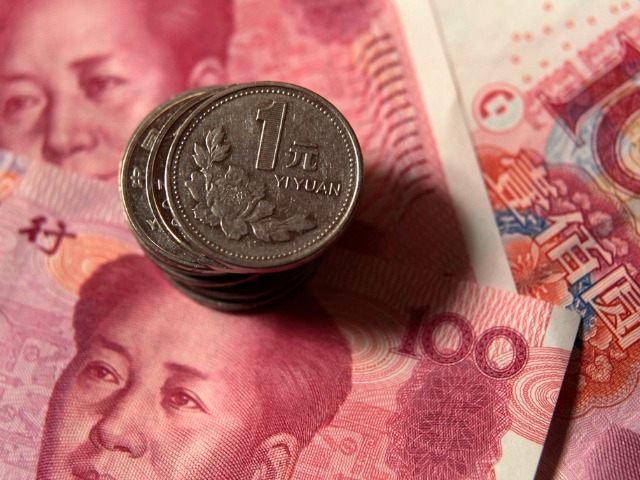Barclay’s Bank estimates that despite a hot stock market, the China suffered $300 billion in capital flight and is facing its first foreign exchange liquidity crisis since 2000. The news follows a report that China’s GDP is experiencing negative growth in real terms, thanks to collapsing domestic demand.
Barclays, like Breitbart Nes, estimates that the Chinese yuan currency is about 20% over-valued because its economy is shrinking, which makes yuan “the most expensive currency globally.” Barclays also agrees that internal problems explain why China cannot follow Japan’s 30 percent yen devaluation or Europe’s 15 percent euro devaluation.
But Barclay’s estimates capital flight is over -$300 billion in the last twelve months, more than three times the Chinese official “capital outflow” of -$91.2 billion. Much of that flight is undoubtedly due to Chinese individuals illegally moving wealth off-shore. The prior record periods of China capital outflows were only $165 billion during 2012 and around $60 billion during the Lehman Brothers crisis in the second half of 2008.
To put this level of capital flight in perspective, under U.S. and European sanctions in response to the Ukraine crisis, Russia’s suffered -$151.5 billion in capital flight last year, threatening the solvency of the world’s second-largest energy producer.
Worse than just capital flight, Barclays estimates China’s foreign exchange reserves actually plummeted by $70 billion in the last six months, the first fall since 2000. That indicates that the Peoples’ Bank of China (PBOC) has prevented a big plunge in the value of the yuan by selling huge amounts of US dollars and using proceeds to buy yuan.
Forbes attributes this activity to the central bank trying to help Chinese speculators unwind yuan-dollar carry trades: “For years, they thought the Chinese currency was a one-way bet upwards.” Although officially, Chinese companies raised about $203 billion in U.S.-dollar denominated bonds, Forbes believes Chinese individuals also “gorged on cheap dollar borrowings, snuck the proceeds into China, and invested in high-yielding” shadow bank pools of sub-prime mortgages denominated in yuan.
The Bank of International Settlements estimates this type of U.S. dollar borrowing, with maturities of less than a year, increased from $121 billion in March 2009 to $850 billion in September 2014. But with the dollar exchange rate spiking upwards as the Chinese economy slows, this carry trade is now producing losses. Chinese speculators unwinding transactions are aggravating outflows of US dollars from China’s reserves.
Barclays warns that there is a huge amount of wealth held by a small number of uber-rich individuals inside China that want to leave the country. A Barclays September survey indicated “47% of China’s wealthy say they intend to leave China in five years.”
Victor Shih of the University of California at San Diego pointed out in 2011 that the wealthiest top 1% of Chinese households hold somewhere between two-thirds to almost twice China’s entire the nation’s foreign reserves. Although reserves increased in size to $3.7 trillion, so has the concentration of wealth by the Chinese 1 percent.
Despite rising U.S. economic dominance while China suffers economic contraction, many analysts are perplexed that China’s Shanghai stock index has been the best performing market this year, with a +32.54 gain, versus the U.S. S&P 500 index as the worst performing market with just a +1.08 percent gain this year. But Lombard Street Research explains that “China’s equity market is policy-driven and the authorities have a lot more sway over its performance than in the West.”
Central planners in Beijing pumped about $160 billion in liquidity into the stock market via the central bank’s “pledged supplementary lending” (aka margin stock loans) in a strategy that prevented an even larger capital flight.
This Communist Party-favored stock market speculation motivated 5.75 million new Chinese mom-and-pop retail brokerage accounts to open in the cities of Shanghai and Shenzhen during the month of March.
Fearing a huge backlash from the populace if the market bubble popped, Chinese regulators late Friday clamped down on shadow bank financing for equity purchases and increased the supply of shares available for short sellers. The regulatory move “slammed equity futures” prices, which fell by -5.2 percent, according to Bloomberg.
But then, fearing a possible burst of the stock market bubble, the PBOC today flooded the Chinese banking system with liquidity by announcing its largest “Reserve Requirement Ratio” cut since the Lehman Brothers Crisis in November 2008.
China needs to devalue its currency in order to counter weakening economic growth and slumping exports. But with up to a $1 trillion in yuan-dollar carry trades, devaluing the yuan could risk a metastasizing foreign exchange liquidity crisis as individuals and corporations are forced to dump yuan and buy US dollars.

COMMENTS
Please let us know if you're having issues with commenting.